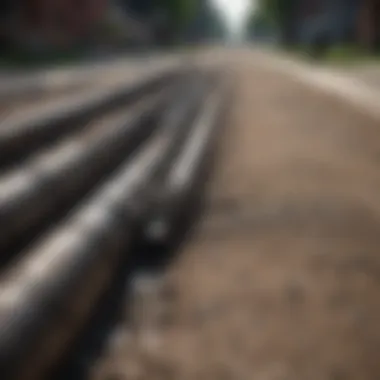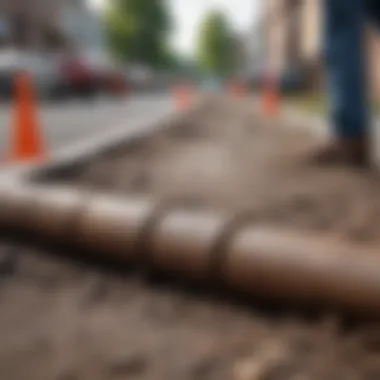Understanding the Cost of Replacing Sewer Lines


Intro
Replacing sewer lines that connect properties to the street is often an overwhelming task for many homeowners. There are numerous components that contribute to determining the cost of such an undertaking. Understanding these factors can help home and property owners make informed decisions. This section provides a foundational overview that sets the stage for a more in-depth exploration.
Sewer line issues can arise for many reasons, including age, environmental factors, and even tree root intrusion. Not only do these problems require immediate professional intervention, but the costs associated with repairs or replacements can vary significantly based on specific circumstances and choices.
Addressing the concerns tied to sewer line replacements is critical for maintaining one's property value and ensuring a reliable sanitation system. This article will delve into the intricacies of the costs involved, helping readers grasp the vital aspects influencing their financial decisions.
Coverage Options
When replacing sewer lines, understanding different coverage options can be incredibly beneficial. Coverage options refer to the available insurance policies or agreements that homeowners can consider in the event of sewer line issues. Having appropriate coverage not only mitigates financial risks but also provides peace of mind.
Types of Coverage Available
- Homeowners Insurance: Typically, a standard homeowners insurance policy might cover some sewer line damages, but the specifics vary. It is critical to consult with your agent about coverage limits and conditions.
- Sewer Backup Insurance: This specific policy covers damages resulting from sewer backup into the home, which is often excluded in standard homeowners policies. Homeowners may need to purchase this as an add-on for comprehensive protection.
- Flood Insurance: Depending on the region, flood insurance is necessary as it helps cover costs arising from flood-related damages that might affect sewer systems.
- Utility Insurance: Utility insurance typically covers repairs for private sewer lines and other utility-related services that connect to municipal systems.
Liability Coverage Explained
Liability coverage in this context refers to the protection homeowners might need if any damages occur during the replacement process. This coverage often addresses potential injuries or damages that might affect third parties, such as neighbors. Adequate liability coverage is essential because it safeguards homeowners against unexpected costs that can arise from accidents.
"Investing in the right insurance coverage can not only protect you financially but also ensure your peace of mind during significant repairs."
Key Considerations
Before deciding on sewer line replacement, several key considerations must be assessed. These include evaluating costs, understanding legal requirements, and considering future implications.
Factors to Assess When Choosing Insurance
- Cost of Premiums: Compare the cost of various insurance policies to find coverage that fits within your budget while still meeting your needs.
- Coverage Limitations: Understand the specifics of what each policy covers, including deductibles and coverage limits.
- Reputation of the Insurer: Research the reputation and reliability of your insurance provider. Customer reviews and ratings can be insightful in making a choice.
Understanding Policy Limits
Policy limits refer to the maximum amount an insurance company will pay out for covered claims. Homeowners must be aware of their policy limits as they can significantly affect the financial outcome in the event of sewer line issues. It is advisable to secure policies with higher limits to ensure full coverage when facing major repairs.
Overview of Sewer Line Replacement
Sewer line replacement is an essential process for property owners as it deals with the underground piping systems that transport wastewater to municipal systems. Proper functioning of these lines is crucial for health and safety. In this article, we will examine the complexity surrounding the replacement of sewer lines and provide insights into costs, preparation, processes, and long-term considerations.
Defining Sewer Line Replacement
Sewer line replacement refers to the process of removing and replacing existing sewer pipes that connect a property to the street. This operation might be necessary due to several reasons, such as deterioration, root intrusion, or significant blockages. The materials currently in use can greatly impact how often replacements are needed. Common materials include PVC, cast iron, or clay—all of which have different lifespans and resistance to environmental elements.
Understanding the specific need for replacement is paramount. It is not just a matter of fixing an issue; it involves a comprehensive assessment of the sewer line's condition. Factors such as age, material, and service history help determine whether replacement is the right path.
Importance of Maintaining Sewer Systems


Maintaining sewer systems is vital for both public health and the environment. A well-functioning sewer system prevents sewage backups, which can lead to health risks and costly repairs. Blockages or breakages can also cause substantial damage to property and even the surrounding infrastructure.
Moreover, failing to replace worn-out sewer lines can lead to more severe consequences, such as leaks that contaminate groundwater sources. Regular inspections and proper maintenance can extend the lifespan of sewer lines and can be less costly in the long run compared to full replacements.
"Preventive maintenance can save thousands in repair costs."
Many homeowners overlook this aspect until problems arise. Understanding the importance of maintaining sewer lines creates awareness around regular inspections and prompt action on repairs—ultimately saving both money and protecting health.
Factors Influencing Replacement Cost
Understanding the cost to replace sewer lines is not a simple matter. It depends on several key factors that can significantly affect the overall financial outlay. Knowing these elements helps homeowners, vehicle owners, and small to medium-sized business owners make informed decisions during the replacement process. Each aspect, whether it’s material choice or site conditions, must be evaluated carefully. A comprehensive grasp of these factors can lead one to anticipate costs and plan effectively, ensuring the project is both successful and financially manageable.
Material Choices for Sewer Lines
When considering sewer line replacement, the choice of material plays a crucial role in shaping overall expenses and performance.
PVC Pipes
PVC pipes are popular due to their lightweight nature and resistance to corrosion. They are particularly beneficial in residential applications where ease of installation and low material cost are important considerations. One key characteristic of PVC is its smooth interior surface, which reduces friction and potential blockages, enhancing flow efficiency over time.
However, PVC does have a drawback: it may not withstand extreme temperatures, which can lead to cracking in certain conditions. Yet, overall, their low price and durability make them an often advantageous option for many homeowners.
Cast Iron
Cast iron pipes are renowned for their durability and longevity. This material is often chosen for commercial projects due to its strength. Cast iron is capable of handling extreme conditions and high traffic above the ground, making it a reliable, though more expensive, choice.
A unique feature of cast iron is its sound-dampening capability. This can be a significant advantage in urban settings where noise reduction is desirable. However, the heavier weight and additional labor costs associated with installation can raise expenses, making it less attractive for some homeowners.
Clay
Clay pipes have been used traditionally due to their natural materials and resistance to corrosion. They are environmentally friendly and have a long lifespan, which can appeal to eco-conscious property owners. One distinctive quality of clay pipes is their ability to resist chemical effects, an essential factor in areas with corrosive soils.
On the downside, clay pipes are susceptible to cracking, especially if the surrounding soil shifts. Also, their installation costs can be higher due to the required handling of heavy materials. Yet, many find the long-term benefits justify the initial expense.
Length of the Replacement
The length of the sewer line that needs replaced directly impacts the cost. Longer lines require more material, and thus the price increases. Additionally, the complexity of installation often grows with distance. Homeowners should measure the total length needed accurately and assess how it correlates with their budget.
Labor Costs
Labor costs are another significant factor. These costs vary widely based on location, contractor experience, and market demand. In urban areas, for example, labor rates are often elevated due to increased demand. It is crucial to obtain multiple quotes from qualified professionals to ensure competitive pricing.
Accessibility and Site Conditions
Finally, site conditions present a major consideration. If the sewer line is located in a challenging area, such as near a busy road or under a large tree, additional work may be required to safely access it. This could add to labor hours and overall project expenses. Homeowners may also need to consider potential additional permit costs if excavation in public spaces is necessary.
Planning for Sewer Line Replacement


Planning for sewer line replacement is a critical phase that influences not just the overall cost, but also the success of the project. An organized approach allows homeowners to anticipate challenges, understand the complexity involved, and ensure compliance with local regulations. Without proper planning, the risk of unforeseen expenses and delays amplifies significantly.
One of the primary benefits of meticulous planning is the ability to identify potential issues early on. By taking the time to conduct thorough inspections and consider various factors, such as soil conditions and existing infrastructure, homeowners can minimize surprises during the replacement process. This proactive measure can lead to a smoother execution and often reduces the long-term costs associated with repairs.
Additionally, understanding the necessary permits required for the project is essential. Each locality has specific rules governing sewer line replacements, which may require permits to be obtained ahead of time. Failing to address these legal requirements can halt progress, resulting in extra expenses and frustration.
Conducting a Sewer Line Inspection
Video Inspection Technologies
Video inspection technologies are a modern solution that can revolutionize the way sewer lines are assessed before replacement. This method employs small cameras that are inserted into the sewer line, providing a live feed of the internal condition of the pipes. A key characteristic of video inspection is its ability to capture high-resolution images and footage, enabling accurate diagnosis of issues like blockages or cracks.
This approach is beneficial because it minimizes the need for excessive excavation, therefore reducing disruption and costs.
However, it is essential to acknowledge some limitations. The effectiveness of video inspection is contingent upon the condition of the existing pipes. If they are significantly damaged, this method may not yield the best results.
Identifying Blockages and Damage
Identifying blockages and damage is a fundamental aspect of preparing for sewer line replacement. Through inspections, property owners can pinpoint specific areas that need attention. The primary benefit of recognizing problem areas early in the process is that it allows for targeted repairs instead of an entire overhaul of the sewer system.
The unique feature of identifying blockages is its potential to save time and money. Homeowners can prioritize repairs to the most severely affected areas, preventing further complications down the line. However, the downside may include possible overlooked issues that can arise if the inspection is incomplete or rushed.
Permitting and Regulations
Permitting and regulations add another layer of complexity to the replacement planning process. Homeowners must be aware of local laws governing sewer line work. Engaging with local authorities early ensures that all necessary permits are obtained, reducing the risk of fines or work stoppages. This aspect cannot be emphasized enough, as non-compliance can lead to substantial delays and heightened costs.
Budgeting for the Project
Budgeting for the project is perhaps the most significant consideration of all. Understanding the total costs involved helps homeowners make informed decisions. Costs can vary widely based on factors such as material choices, labor, and unexpected contingencies. Homeowners should consider all potential expenses, including permits, inspections, and post-replacement cleanup.
By creating a detailed budget, it is easier to navigate the financial aspects of the project. This clarity allows for better financial planning, which is crucial in avoiding overspending and ensuring that funds are available for all necessary components of the sewer line replacement.
The Sewer Line Replacement Process
The process of replacing sewer lines is a significant aspect in this discussion, as it entails comprehensive planning and execution. Understanding this process is vital for homeowners and professionals alike, as it not only impacts the immediate environment but also ensures long-term reliability and efficiency of sewer systems. Knowing the steps involved, from selecting contractors to the actual replacement procedures, can save time and costs while guaranteeing that the work adheres to necessary regulations.
Choosing a Contractor
Qualifications and Experience
When selecting a contractor for sewer line replacement, qualifications and experience stand out as crucial factors. A contractor with extensive qualifications brings a wealth of knowledge to the project. Their experience can make a considerable difference in achieving high standards of workmanship and compliance with local codes. Renowned contractors often have established relationships with suppliers and city inspectors, which could expedite the permit approval process. The unique feature of this area is that experience in similar projects can allow for efficient problem-solving, minimizing delays. However, it is also critical to ensure that the contractor’s qualifications are genuine and verified.
Obtaining Quotes
Obtaining quotes is another essential part of choosing a contractor. This process provides insight into the overall estimated cost of replacing sewer lines. Each quote allows homeowners to compare different contractors and understand market rates. A key characteristic of obtaining multiple quotes is that it gives leverage in negotiations. Homeowners can ask for clarity on each company's charges, ensuring there are no hidden costs. The unique feature of this approach is its ability to identify the best value for money. However, its disadvantage may be the potential for overwhelming options, causing confusion or hesitation in making a decision.
The Replacement Procedure


Excavation Techniques
The method of excavation plays a significant role in the sewer line replacement process. Different excavation techniques, like trenching or hydro excavation, can impact both the timeline and cost of the project. A key characteristic of excavation methods is their adaptability to site conditions. For example, hydro excavation is often preferred in densely populated areas due to its less disruptive nature. A unique feature is that it reduces the risk of damaging existing underground utilities, thus minimizing costly setbacks. However, one disadvantage may be the higher upfront costs associated with advanced techniques.
Pipe Installation Methods
Pipe installation methods also greatly affect the overall effectiveness of the replacement. Options vary from traditional methods to more modern techniques like trenchless technology. A significant aspect of this is the choice of materials, such as PVC or cast iron, which can influence durability and maintenance needs. A unique feature of trenchless methods is that they substantially reduce the amount of surface disruption required. However, while this method is efficient, it may not always be feasible for older systems requiring extensive repairs.
Post-Replacement Inspections
Post-replacement inspections are essential to ensure that the new sewer lines function as intended. This step typically involves visually checking the work done and potentially conducting tests to ascertain overall functionality. Homeowners should actively engage in this process, as it serves as a safeguard against future complications. A thorough inspection can highlight any issues before they escalate, offering peace of mind to property owners. In summary, understanding the sewer line replacement process is crucial for making informed choices, ensuring quality work, and preserving property value.
Long-Term Considerations
Understanding long-term considerations is essential for homeowners looking to replace sewer lines. Investing in a proper sewer line replacement can lead to significant benefits over time. Proper care and awareness of long-term issues can save money and stress.
Maintenance Practices for New Sewer Lines
Once sewer lines are replaced, regular maintenance becomes crucial. Homeowners should adopt a routine that involves:
- Performing periodic inspections to identify any signs of wear or damage.
- Avoiding the disposal of unsuitable materials down the drain, such as grease or non-biodegradable items.
- Ensuring that landscaping does not interfere with sewer access points.
- Conducting a professional inspection every few years to assess pipe alignment and integrity.
By following these practices, homeowners can extend the life of their new sewer lines and mitigate future issues.
Impact on Property Value
Replacing old sewer lines can notably enhance a property’s value. Buyers often look for well-maintained plumbing systems. A new sewer line ensures that:
- There is reduced risk of future sewer problems, which can deter potential buyers.
- It may lead to lower insurance costs, as insurers consider properties with updated systems safer.
- The overall appeal of the property increases due to the elimination of unpleasant odors or flooding issues associated with older lines.
In many cases, the cost of replacing sewer lines can be regained upon resale of the property.
Common Issues After Replacement
Despite proper planning and execution, issues may still arise after replacing sewer lines. Homeowners should be aware of:
- Settling Issues: New lines sometimes shift or settle improperly, leading to blockages.
- Backflow Problems: If not installed correctly, backflow could result, posing health risks.
- Tree Root Intrusion: Even after replacement, tree roots can sometimes find their way into joints, causing future blockages.
- Regular backups: Homeowners may still experience issues if not maintained correctly.
Addressing these potential problems early can prevent extensive damage and costly repairs in the future.
Pro Tip: Always consult with professionals if issues arise post-installation. They can provide targeted solutions tailored to specific problems.
Culmination
Understanding the cost to replace sewer lines is essential for both homeowners and industry professionals. Navigating the intricacies can save time and money in the long run. Several factors influence the overall cost and potential inconveniences that come with the replacement of your sewer system.
Recap of Key Points
- Importance of Maintenance: Regular inspections and maintenance ensure a healthy sewer system, preventing costly emergency repairs.
- Factors Influencing Costs: Material choices, length of replacement, labor costs, and site accessibility contribute to the pricing of the project.
- Planning is Crucial: A thorough inspection is vital to identify issues before replacement. Securing the necessary permits is also an important step, ensuring compliance with any regulations.
- Choosing the Right Contractor: The qualifications and experience of your contractor can hugely impact the success of the project. Obtaining multiple quotes allows for better financial planning.
- Long-Term Implications: New sewer lines require ongoing maintenance practices. Understanding the common after-replacement issues can help mitigate future problems.
Final Thoughts on Sewer Line Replacement Costs
The endeavor to replace sewer lines should not be viewed solely as a cost but rather as an investment in a property’s infrastructure. The benefits of a well-functioning sewer system can translate into greater property value and enhanced overall efficiency. Homeowners should always seek multiple estimates for competitive pricing. Moreover, they should prioritize quality over cost alone. While it might be tempting to select the lowest bid, this can lead to more expenses in repairs and maintenance down the line.



